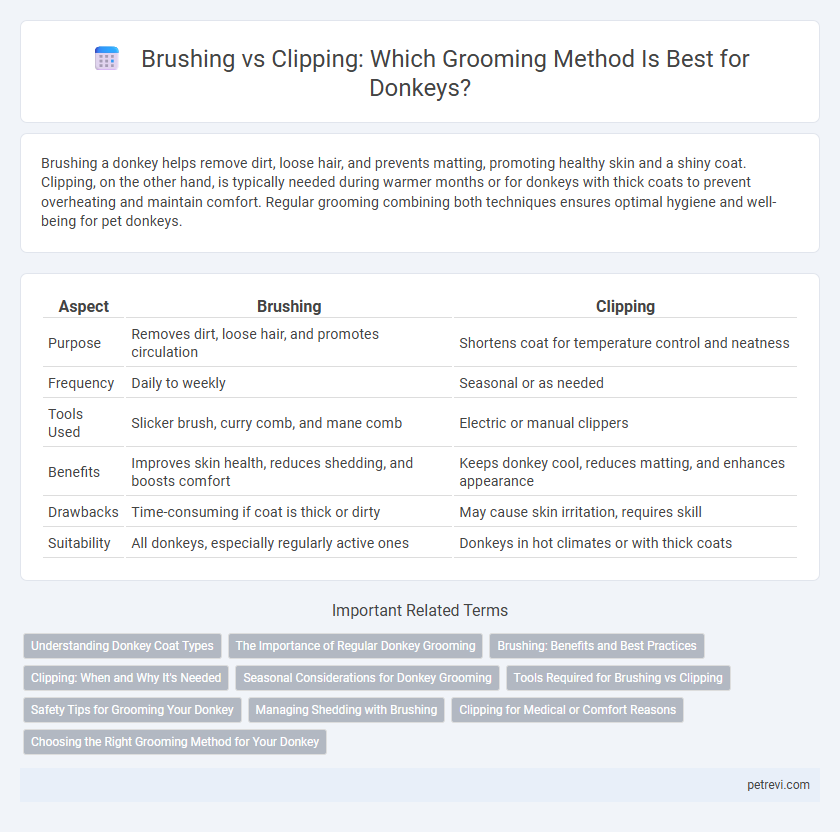Brushing a donkey helps remove dirt, loose hair, and prevents matting, promoting healthy skin and a shiny coat. Clipping, on the other hand, is typically needed during warmer months or for donkeys with thick coats to prevent overheating and maintain comfort. Regular grooming combining both techniques ensures optimal hygiene and well-being for pet donkeys.
Table of Comparison
| Aspect | Brushing | Clipping |
|---|---|---|
| Purpose | Removes dirt, loose hair, and promotes circulation | Shortens coat for temperature control and neatness |
| Frequency | Daily to weekly | Seasonal or as needed |
| Tools Used | Slicker brush, curry comb, and mane comb | Electric or manual clippers |
| Benefits | Improves skin health, reduces shedding, and boosts comfort | Keeps donkey cool, reduces matting, and enhances appearance |
| Drawbacks | Time-consuming if coat is thick or dirty | May cause skin irritation, requires skill |
| Suitability | All donkeys, especially regularly active ones | Donkeys in hot climates or with thick coats |
Understanding Donkey Coat Types
Donkey coat types vary from short and thin in warmer climates to thick and woolly in colder regions, influencing grooming methods such as brushing or clipping. Brushing is effective for short-haired donkeys to remove dirt and loose hair while promoting circulation, whereas clipping is more suitable for thick-coated donkeys to manage excess hair and prevent overheating. Understanding these distinct coat characteristics ensures proper grooming that supports donkey health and comfort throughout seasonal changes.
The Importance of Regular Donkey Grooming
Regular donkey grooming is essential for maintaining healthy skin and coat, preventing parasites, and promoting circulation. Brushing helps remove dirt, loose hair, and debris while enhancing natural oils for a shiny coat, whereas clipping manages excess hair, especially in warmer climates or during shedding seasons. Consistent grooming routines reduce the risk of skin infections and improve overall donkey comfort and well-being.
Brushing: Benefits and Best Practices
Brushing a donkey promotes healthy skin by removing dirt, debris, and loose hair, which prevents skin infections and enhances coat shine. Regular brushing stimulates blood circulation and strengthens the bond between owner and donkey, supporting overall animal welfare. Best practices include using appropriate brushes for sensitive donkey skin and brushing in the direction of hair growth to avoid discomfort.
Clipping: When and Why It's Needed
Clipping a donkey's coat is essential during warmer months to prevent overheating and maintain skin health, especially if the donkey is clipped regularly for show or therapeutic purposes. It helps remove thick winter hair that can trap dirt and moisture, reducing the risk of skin infections and parasites. Clipping also facilitates easier grooming, improves comfort, and supports the donkey's overall well-being in hot climates.
Seasonal Considerations for Donkey Grooming
Brushing is essential for removing dirt and loose hair during spring and fall when donkeys shed their coats, promoting healthy skin and preventing matting. Clipping is typically reserved for warmer seasons or donkeys with thick winter coats, helping to regulate their body temperature and prevent overheating. Seasonal grooming adjustments ensure donkeys maintain comfort and skin health throughout varying weather conditions.
Tools Required for Brushing vs Clipping
Effective donkey grooming requires specific tools tailored to brushing or clipping. Brushing tools typically include curry combs, stiff brushes, and soft finishing brushes to remove dirt, stimulate skin, and promote coat health. Clipping necessitates electric clippers with appropriate blades, clipper oil, and scissors for precision trimming, ensuring the donkey's comfort and a neat appearance.
Safety Tips for Grooming Your Donkey
When grooming your donkey, always prioritize safety by using gentle brushes to avoid skin irritation and respect the donkey's sensitive areas. Clipping requires careful handling with clean, sharp clippers and a calm environment to prevent cuts and stress. Ensure proper restraint and regularly check for any signs of discomfort or injury during both brushing and clipping sessions.
Managing Shedding with Brushing
Managing shedding in donkeys is most effective through regular brushing, which removes loose hair and prevents matting during seasonal coat changes. Brushing stimulates natural oils in the skin, promoting a healthy and shiny coat while reducing dirt buildup. Unlike clipping, brushing maintains the donkey's natural insulation and helps monitor skin health for early detection of irritations or parasites.
Clipping for Medical or Comfort Reasons
Clipping is essential for donkeys with thick or dense coats, especially in warmer climates or during medical treatments to prevent overheating and skin infections. It eases the application of topical medications and allows better monitoring of wounds or irritations. Proper clipping enhances overall comfort and helps maintain healthy skin conditions in donkeys prone to sweating or parasite infestation.
Choosing the Right Grooming Method for Your Donkey
Brushing is essential for removing dirt, loose hair, and preventing skin irritations in donkeys, making it ideal for regular grooming and maintaining coat health. Clipping is recommended in hot climates or during heavy shedding seasons to help regulate body temperature and reduce parasite issues. Choose brushing for everyday care and clipping when environmental conditions or specific health concerns demand more intensive coat management.
Brushing vs Clipping for Donkey Grooming Infographic

 petrevi.com
petrevi.com